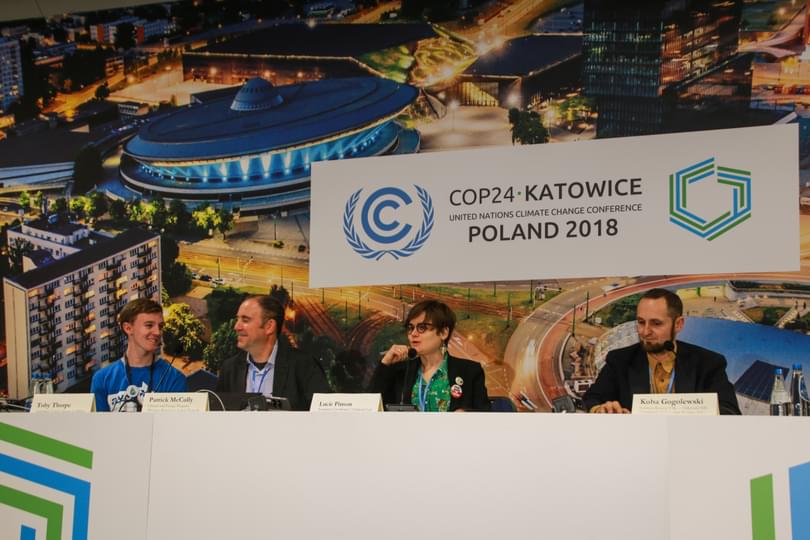
Photo credit: Meghan M. Shea
Leading thinkers on climate change from the University of Oxford, the University of Reading and the University of Victoria, Wellington today warned the UNFCCC that measurement rules in current draft texts at COP 24 could make it impossible to assess mitigation measures against a long-term temperature goal.
They assert that the CO2-equivalent metric as presented “seriously misrepresents the climate impact of methane emissions” as methane does not accumulate in the atmosphere over time as CO2 does. Professor Myles Allen of the University of Oxford likened the conventional approach to combining greenhouse gases in COP24’s current draft text to “adding your current speed to the distance you have already travelled to get some nonsense measure of ‘aggregate distance-equivalent’.”
The full statement from Professor Myles Allen, Dr Michelle Cain, Dr John Lynch and Professor Raymond Pierrehumbert, University of Oxford; Professor Keith Shine, University of Reading; Professor David Frame and Dr Adrian Macey, University of Victoria, Wellington follows:
“Without an assessment of its impact, or a thorough review of available options, the UNFCCC negotiations in Poland may be converging on accounting rules for different greenhouse gases that could miss an opportunity clarify what their commitments actually mean, and lock in problems on multiple fronts for the future. Current proposals could make it more challenging for countries with historically large rice production or bovine agriculture sectors to engage in climate action while at the same time failing to appropriately discourage climatically dangerous increases in methane emissions from new sources such as fracking. Worst of all, they make it impossible to assess the implications of countries’ commitments against progress to a long-term temperature goal.
“The draft text of the ‘transparency framework’ in support of the Paris Agreement states ‘each Party shall use the 100-year time horizon global warming potential (GWP) values … to report aggregate emissions and removals of GHGs, expressed in carbon dioxide equivalent (CO2 eq).’ This enshrines the practice of combining emissions of long-lived cumulative pollutants such as CO2 with relatively short-lived pollutants such as methane (produced by cows, sheep, rice cultivation and fracking) into a single aggregate ‘CO2-equivalent’ emission.
“The problem, as has long been known, is that global temperatures respond fundamentally differently to methane and CO2: the rate of methane emissions determines methane's contribution to the current temperature level, while the rate of CO2 emissions determines CO2’s contribution to current rate of temperature increase. Adding them together seriously misrepresents the climate impact of methane emissions especially when these are constant or falling.
“If only a single number for CO2-equivalent emissions is reported using conventional GWP, it will perpetuate misunderstandings about the contributions of different gases to global temperature, leading to an increasingly indefensible split between our climate policy framework and climate science.
“There is, however, a simple solution: in pursuit of an ambitious global temperature goal, treat all gases equally in terms of their impact on global temperature. This can still be done with GWP but via a different usage. Instead of equating one-off (“pulse”) emissions of two gases using the GWP, as is conventional, a more sound comparison of climate impact is to equate a permanent one-tonne-per-year increase in emissions of any short-lived pollutant, such as methane, with a one-off emission of a fixed number of tonnes of CO2: the conversion factor is just the GWP times the time-horizon.
“Global temperatures react to a one-tonne-per-year increase in methane emissions just like a one-off emission of 2800 tonnes of CO2. The climate system also equates steady, or gently declining, methane emissions (such as produced by a long-established agricultural sector) with near-zero CO2 emissions, since steady or declining methane emissions are no longer contributing to any further increase in global temperatures (even though they could still present an opportunity for mitigation).
“As noted in the recent IPCC 1.5°C Special Report, aggregate emissions combined in this way track the progress of global temperature remarkably accurately, making it easy to assess their implications for a long-term temperature goal. By contrast, the conventional usage of GWP-100 would equate that increase in methane emissions with only a 28-tonnes-per-year increase in CO2 emissions, massively underestimating its immediate impact, while at the same time incorrectly equating steady or declining methane emissions with a long-term commitment to increasing temperature.
“The single extra piece of information required in the transparency framework to make clear the implications of reported emissions for global temperature is for countries to report, in addition to their aggregate total CO2-equivalent emissions, the contribution to that total of very long-lived gases (those, like CO2 and nitrous oxide, with effective lifetimes exceeding 100 years). These gases, unlike methane, accumulate in the climate system, so we need to know how fast they are accumulating to determine the resulting long-term temperature commitment. With that additional information, everything becomes transparent. It is not too late to include it.”
Professor Myles Allen, Dr Michelle Cain, Dr John Lynch and Professor Raymond Pierrehumbert, University of Oxford; Professor Keith Shine, University of Reading; Professor David Frame and Dr Adrian Macey, University of Victoria, Wellington.